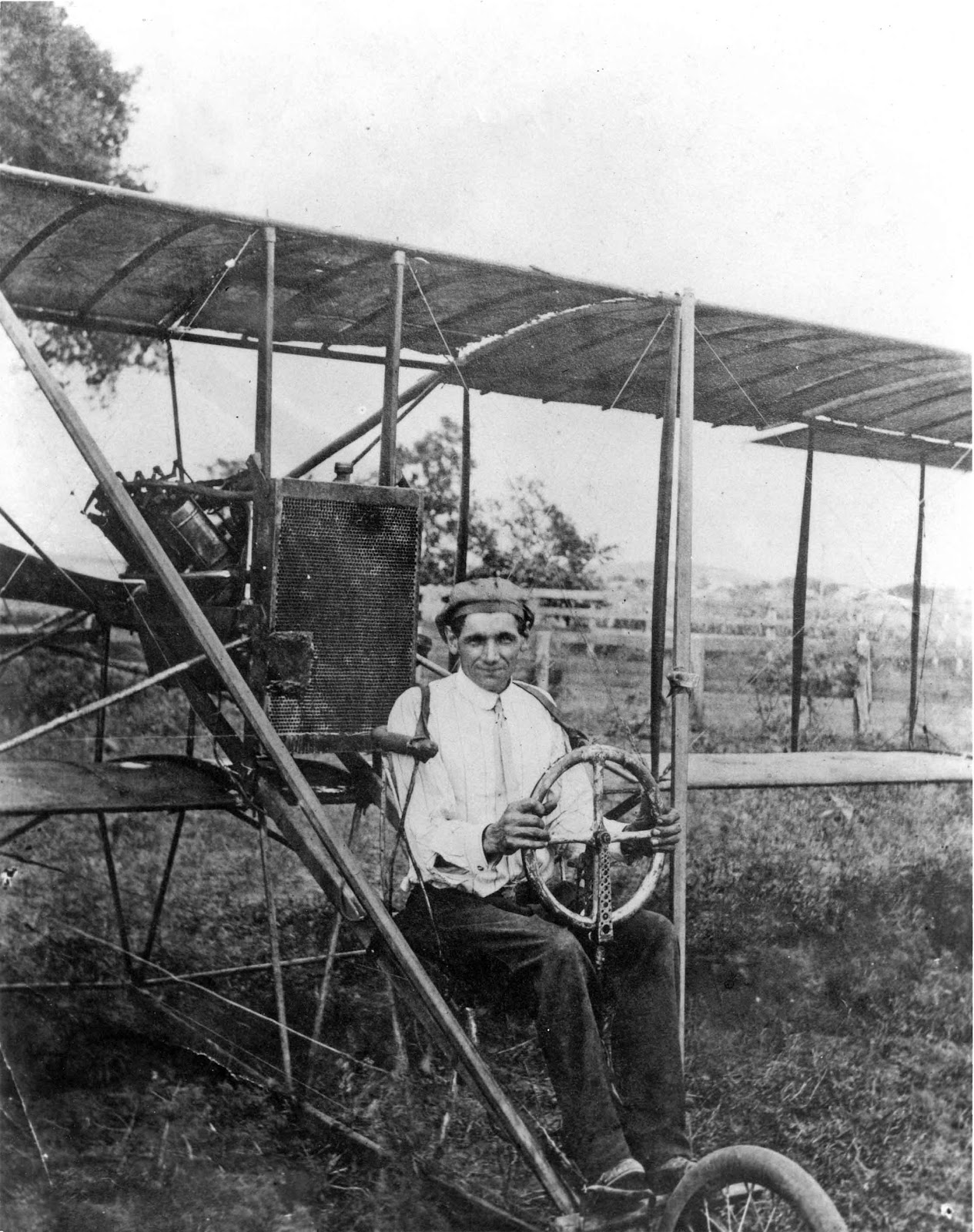 |
| Capt. Charles Theodore and his Curtiss 'aeroplane' at Kerrville's West Texas Fairgrounds, 1916. Click on any image to enlarge. |
Years ago, my long-time friend and classmate Carol Neely dropped by our print shop with two very interesting photographs of a man and his airplane. The photos were part of her late father’s collection, and I was very thankful to receive them.
The two photos show an early biplane: one showing a closeup of the pilot, and then another showing the entire plane along with the pilot and another young man. Calvin Neely had labeled the photos “First Aeroplane in Kerrville….”
As you know, I love a mystery, so I decided to investigate.
Here are the clues I saw in the photographs:
First, I think the “aeroplane” was photographed at the West Texas Fairgrounds, which once stood between Guadalupe Street and Junction Highway, and bordered, roughly, by Hugo Street and Lewis Avenue. The big clue as to the location of the airplane in the photographs is just behind the men and the machine: you can make out the inner and outer fences of the fairground’s racetrack.
The West Texas Fair was a big deal. Not only was it a place to show off agricultural, livestock, and homemade items, it also offered horse racing and other entertainments. Those entertainments changed from year to year, but they were designed to bring in the crowds.
The July 29, 1916 issue of the Kerrville Mountain Sun has an article headlined “Airship to Fly Over Kerrville.”
In 1916 airplanes were a rare thing here. I checked the local newspapers for the years 1914 and 1915; there were no reports of “aeroplanes” coming to Kerrville. The U.S. Army had an airbase at Fort Sam Houston, testing a Wright Brothers plane in 1911, and accepting a Curtiss Model D Type IV in April of 1911. I’m not sure those planes had a very great range, but it’s conceivable an airplane could have come close to Kerrville sometime between 1911 and 1916.
“The West Texas Fair,” the article reports, “will offer the people of this section a new thriller this year…. The people will be able to witness a thing of which we have all heard and read, and which few of us have seen – a birdman in the air demonstrating the manner in which aeroplanes are handled in the great European war.”
Captain Charles Theodore flew an aircraft during Kerrville’s West Texas Fair in mid-August, 1916. I believe the young man in the photograph is Charles Theodore.
Theodore was a popular aviator in Texas, and often appeared and performed at fairs and public gatherings. In an advertisement for a show in McKinney, Texas in 1917, he is headlined as “Captain Charles Theodore and his Curtiss Airplane,” and a photograph shows such an airplane in flight.
Looking closely at the two photographs of the aeroplane in Kerrville, it appears to be a modified Curtiss Model D Headless Pusher. The pusher part of the name comes from the propeller positioned at the back of the aircraft, pushing air away from the front of the plane for power; the headless part comes from the absence of a canard in front of the pilot. It was made of wood and cloth and looks absolutely terrifying to fly.
I believe the aeroplane photographed in Kerrville matches the photographs of the plane in the advertisements elsewhere.
Waco was, for a while, Theodore’s home base. In 1916, the local Young Men’s Business League had collected $1000 for him to “establish a flying field” on land donated by “one of Waco’s “most prominent citizens.” Theodore stayed there for a year or so, and it was during this time he put on a show in Kerrville. Later he moved up to Dallas, to a new airfield opening there.
I found two news articles describing separate crashes Capt. Theodore survived while performing. Flying was especially dangerous in those days, but he kept flying.
He continued to fly and perform until October, 1919. While doing stunts for a show in Dallas, in a more modern and powerful Curtiss JN-4 Canadian, and after walking along the wings of the aircraft while a fellow pilot was at the controls, he attempted to hang on to the landing frame while the plane did a loop. This crazy stunt was not successful, and he fell to earth.
He was clear-eyed about the risks of aviation, if not about evaluating extra risks. In an interview he once said “Yes. I guess I will get mine someday – they nearly all do – but in the meantime it is a fascinating game – and well, I am in that business, and do not have any intention of getting into anything else.”
He was only 37 when he died, and had been flying for about 10 years. He was probably the first person to fly an airplane here in Kerrville.
I’m thankful Ms. Neely shared these wonderful photographs with all of us.
Until next week, all the best.
Joe Herring Jr. is a Kerrville native who often flew with his mother when she had her private pilot’s license. She didn’t allow wing-walking. This column appeared in the Kerr County Lead August 1, 2024.
Thanks for reading. This newsletter is free, but not cheap to send. To show your support, forward it to someone who’d like it, or buy one of my books. Thanks so much. (And thanks to all of you who bought books this week!)
Never miss a story from Joe. Join today for FREE.




Wow!!👍
ReplyDeleteThis is a really interesting post about the first airplane in Kerrville. In studying the photo of the airplane, it appears to be an early Martin pusher with a Curtiss engine. The framing and tail style matches that of a early Martin types, but with added ailerons. Anyway, thank you for sharing.
ReplyDelete